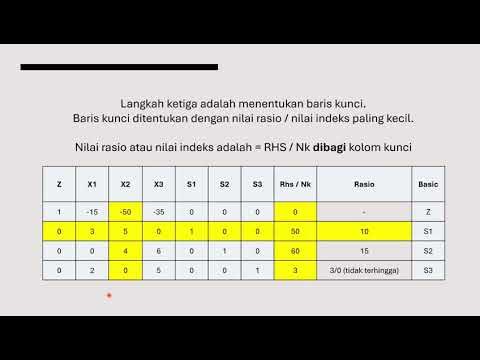Linear Programming, GAMPANG BANGET!
Summary
TLDRIn this video, the speaker simplifies the concept of linear programming, a technique used to help businesses make optimal decisions for resource allocation. Starting with a personal anecdote, the speaker demonstrates how linear programming can maximize profit in a small business setting, like producing tofu and tempe. Through a step-by-step breakdown of a production scenario, the video explains how to set up constraints, define decision variables, and solve the problem using graphical methods. The speaker encourages viewers not to be intimidated by the mathematical symbols and assures that the method is easy to grasp.
Takeaways
- 😀 Linear programming is a mathematical technique designed to help managers make decisions on resource allocation.
- 😀 Linear programming is often seen as intimidating due to complex symbols, but it is actually quite simple once broken down.
- 😀 The concept is useful for anyone, from business owners to engineers, in optimizing resources and maximizing profit.
- 😀 A basic example involves a small business producing tofu and tempeh, with limited resources (time and production capacity).
- 😀 The goal in this example is to maximize profit, where tofu and tempeh are sold at different prices and have different production times.
- 😀 The problem is broken down into a linear programming model with variables, constraints, and an objective function to maximize profit.
- 😀 The objective function is defined as the total profit, where the profit from tofu is $30 per unit and tempeh is $40 per unit.
- 😀 Constraints include the total production capacity (100 units per month) and limited production time (240 hours per month).
- 😀 The linear programming model uses inequalities to represent these constraints, such as the number of units and total production hours.
- 😀 By solving the system of constraints using graphical methods, the optimal production combination is found to be 60 tofu and 40 tempeh per month for maximum profit.
Q & A
What is linear programming?
-Linear programming is a mathematical technique used to find the best possible solution to problems with constraints. It helps managers allocate limited resources efficiently to maximize profits or achieve other specific goals.
Why was linear programming intimidating in the past for the speaker?
-The speaker found linear programming intimidating initially because of the complex symbols and mathematical notations, which made it difficult to understand. However, they emphasize that it is actually easy once the concepts are broken down.
What is the goal of linear programming in a business context?
-In a business context, the goal of linear programming is to help businesses maximize their profits while working within constraints like limited resources, time, or capital.
How does linear programming apply to the example of tofu and tempe production?
-In the example, linear programming is used to determine how many units of tofu and tempe should be produced to maximize profit, while considering the constraints of production time and the limited total number of units that can be produced each month.
What are the constraints in the tofu and tempe example?
-The constraints include: a maximum of 100 units of tofu and tempe combined per month, a total production time of 240 hours per month, and the requirement that the number of tofu and tempe produced cannot be negative.
What does the profit function look like in this example?
-The profit function is given by: Z = 30X1 + 40X2, where X1 is the number of tofu units produced and X2 is the number of tempe units produced. The goal is to maximize this profit.
What does the speaker mean by 'decision variables' in this context?
-In the context of the tofu and tempe example, the decision variables are the number of tofu (X1) and tempe (X2) units to produce. These are the variables that the business can control to maximize profit.
What method does the speaker recommend for solving this linear programming problem?
-The speaker recommends using the graphical method to solve the linear programming problem. This involves plotting the constraints on a graph and finding the feasible region, where all the constraints overlap.
Why is the graphical method considered simple for solving linear programming problems?
-The graphical method is considered simple because it allows you to visually identify the feasible region and the optimal solution by examining the vertices of this region. It’s an intuitive way to solve problems with two decision variables.
How does the speaker determine the optimal solution in this example?
-The optimal solution is found by testing the vertices of the feasible region. The solution that gives the highest profit when plugged into the profit function is selected. In this case, producing 60 units of tofu and 40 units of tempe yields the highest profit.
Outlines

This section is available to paid users only. Please upgrade to access this part.
Upgrade NowMindmap

This section is available to paid users only. Please upgrade to access this part.
Upgrade NowKeywords

This section is available to paid users only. Please upgrade to access this part.
Upgrade NowHighlights

This section is available to paid users only. Please upgrade to access this part.
Upgrade NowTranscripts

This section is available to paid users only. Please upgrade to access this part.
Upgrade NowBrowse More Related Video

Metode Simplex dengan 3 Variable - Riset Operasional

PROGRAM LINIER - METODE GRAFIK - RISET OPERASI

ART TEACHES MATHEMATICS IN THE MODERN WORLD-LESSON 1: INTRO TO LINEAR PROGRAMMING

RISET OPERASI atau OPERATION RESEARCH part #1 || JURUSAN MANAJEMEN - Albert Steinado

What is MoSCoW Prioritization Method? Definition, Overview, and Best Practices

How to Perform Marketing Analysis | 7 Dimensions for Every Market
5.0 / 5 (0 votes)